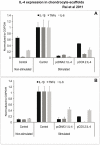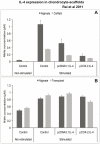Evidence for regulated interleukin-4 expression in chondrocyte-scaffolds under in vitro inflammatory conditions
- PMID: 21991344
- PMCID: PMC3185011
- DOI: 10.1371/journal.pone.0025749
Evidence for regulated interleukin-4 expression in chondrocyte-scaffolds under in vitro inflammatory conditions
Abstract
Objective: To elucidate the anti-inflammatory and anabolic effects of regulated expression of IL-4 in chondrocyte-scaffolds under in vitro inflammatory conditions.
Methods: Mature articular chondrocytes from dogs (n = 3) were conditioned through transient transfection using pcDNA3.1.cIL-4 (constitutive) or pCOX-2.cIL-4 (cytokine-responsive) plasmids. Conditioned cells were seeded in alginate microspheres and rat-tail collagen type I matrix (CaReS®) to generate two types of tissue-engineered 3-dimensional scaffolds. Inflammatory arthritis was simulated in the packed chondrocytes through exogenous addition of recombinant canine (rc) IL-1β (100 ng/ml) plus rcTNFα (50 ng/ml) in culture media for 96 hours. Harvested cells and culture media were analyzed by various assays to monitor the anti-inflammatory and regenerative (anabolic) properties of cIL-4.
Results: cIL-4 was expressed from COX-2 promoter exclusively on the addition of rcIL-1β and rcTNFα while its expression from CMV promoter was constitutive. The expressed cIL-4 downregulated the mRNA expression of IL-1β, TNFα, IL-6, iNOS and COX-2 in the cells and inhibited the production of NO and PGE(2) in culture media. At the same time, it up-regulated the expression of IGF-1, IL-1ra, COL2a1 and aggrecan in conditioned chondrocytes in both scaffolds along with a diminished release of total collagen and sGAG into the culture media. An increased amount of cIL-4 protein was detected both in chondrocyte cell lysate and in concentrated culture media. Neutralizing anti-cIL-4 antibody assay confirmed that the anti-inflammatory and regenerative effects seen are exclusively driven by cIL-4. There was a restricted expression of IL-4 under COX-2 promoter possibly due to negative feedback loop while it was over-expressed under CMV promoter (undesirable). Furthermore, the anti-inflammatory /anabolic outcomes from both scaffolds were reproducible and the therapeutic effects of cIL-4 were both scaffold- and promoter-independent.
Conclusions: Regulated expression of therapeutic candidate gene(s) coupled with suitable scaffold(s) could potentially serve as a useful tissue-engineering tool to devise future treatment strategies for osteoarthritis.
Conflict of interest statement
Figures








Similar articles
-
Co-expression of insulin-like growth factor-1 and interleukin-4 in an in vitro inflammatory model.Cytokine. 2010 Jun;50(3):297-305. doi: 10.1016/j.cyto.2010.01.010. Epub 2010 Feb 25. Cytokine. 2010. PMID: 20188584
-
Quantification of cytokines and inflammatory mediators in a three-dimensional model of inflammatory arthritis.Cytokine. 2008 Apr;42(1):8-17. doi: 10.1016/j.cyto.2008.02.004. Epub 2008 Mar 17. Cytokine. 2008. PMID: 18343681
-
Expression of canine interleukin-4 in canine chondrocytes inhibits inflammatory cascade through STAT6.Cytokine. 2008 Oct;44(1):179-84. doi: 10.1016/j.cyto.2008.07.470. Epub 2008 Sep 11. Cytokine. 2008. PMID: 18789870
-
Enhanced hyaline cartilage matrix synthesis in collagen sponge scaffolds by using siRNA to stabilize chondrocytes phenotype cultured with bone morphogenetic protein-2 under hypoxia.Tissue Eng Part C Methods. 2013 Jul;19(7):550-67. doi: 10.1089/ten.TEC.2012.0508. Epub 2013 Feb 19. Tissue Eng Part C Methods. 2013. PMID: 23270543
-
Mechanisms and in vivo functions of contact inhibition of locomotion.Nat Rev Mol Cell Biol. 2017 Jan;18(1):43-55. doi: 10.1038/nrm.2016.118. Epub 2016 Sep 28. Nat Rev Mol Cell Biol. 2017. PMID: 27677859 Review.
Cited by
-
The Role of Interleukin-4 and Interleukin-10 in Osteoarthritic Joint Disease: A Systematic Narrative Review.Cartilage. 2022 Apr-Jun;13(2):19476035221098167. doi: 10.1177/19476035221098167. Cartilage. 2022. PMID: 35549461 Free PMC article.
-
DNA Sequence Variants in the Five Prime Untranslated Region of the Cyclooxygenase-2 Gene Are Commonly Found in Healthy Dogs and Gray Wolves.PLoS One. 2015 Aug 5;10(8):e0133127. doi: 10.1371/journal.pone.0133127. eCollection 2015. PLoS One. 2015. PMID: 26244515 Free PMC article.
-
Platelet-Rich Plasma Released From Polyethylene Glycol Hydrogels Exerts Beneficial Effects on Human Chondrocytes.J Orthop Res. 2019 Nov;37(11):2401-2410. doi: 10.1002/jor.24404. Epub 2019 Jul 22. J Orthop Res. 2019. PMID: 31254416 Free PMC article.
-
Experimentally induced cartilage degeneration treated by pulsed electromagnetic field stimulation; an in vitro study on bovine cartilage.BMC Musculoskelet Disord. 2015 Oct 20;16:308. doi: 10.1186/s12891-015-0760-6. BMC Musculoskelet Disord. 2015. PMID: 26480822 Free PMC article.
-
Extracellular and intracellular mechanisms of mechanotransduction in three-dimensionally embedded rat chondrocytes.PLoS One. 2014 Dec 5;9(12):e114327. doi: 10.1371/journal.pone.0114327. eCollection 2014. PLoS One. 2014. PMID: 25479057 Free PMC article.
References
-
- Pelletier JP, Martel-Pelletier J, Abramson SB. Osteoarthritis, an inflammatory disease: potential implication for the selection of new therapeutic targets. Arthritis Rheum. 2001;44:1237–1247. - PubMed
-
- Hegemann N, Wondimu A, Kohn B, Brunnberg L, Schmidt MF. Cytokine profile in canine immune-mediated polyarthritis and osteoarthritis. Vet Comp Orthop Traumatol. 2005;18:67–72. - PubMed
-
- Nuki G. Role of mechanical factors in the aetiology, pathogenesis and progression of osteoarthritis. In: Reginster JY, Pelletier JP, Martel-Pelletier J, Henrotin Y, editors. Osteoarthritis: Clinical and Experimental Aspects. Berlin: Springer-Verlag; 1999. pp. 101–114.
-
- Pelletier JP, Martel-Pelletier J, Howell DS. Etiopathogenesis of osteoarthritis. In: Koopman WJ, editor. Arthritis & Allied Conditions. A Textbook of Rheumatology. 14th ed. Baltimore: Williams & Wilkins; 2000. pp. 2195–2245.
Publication types
MeSH terms
Substances
LinkOut - more resources
Full Text Sources
Other Literature Sources
Research Materials
Miscellaneous

